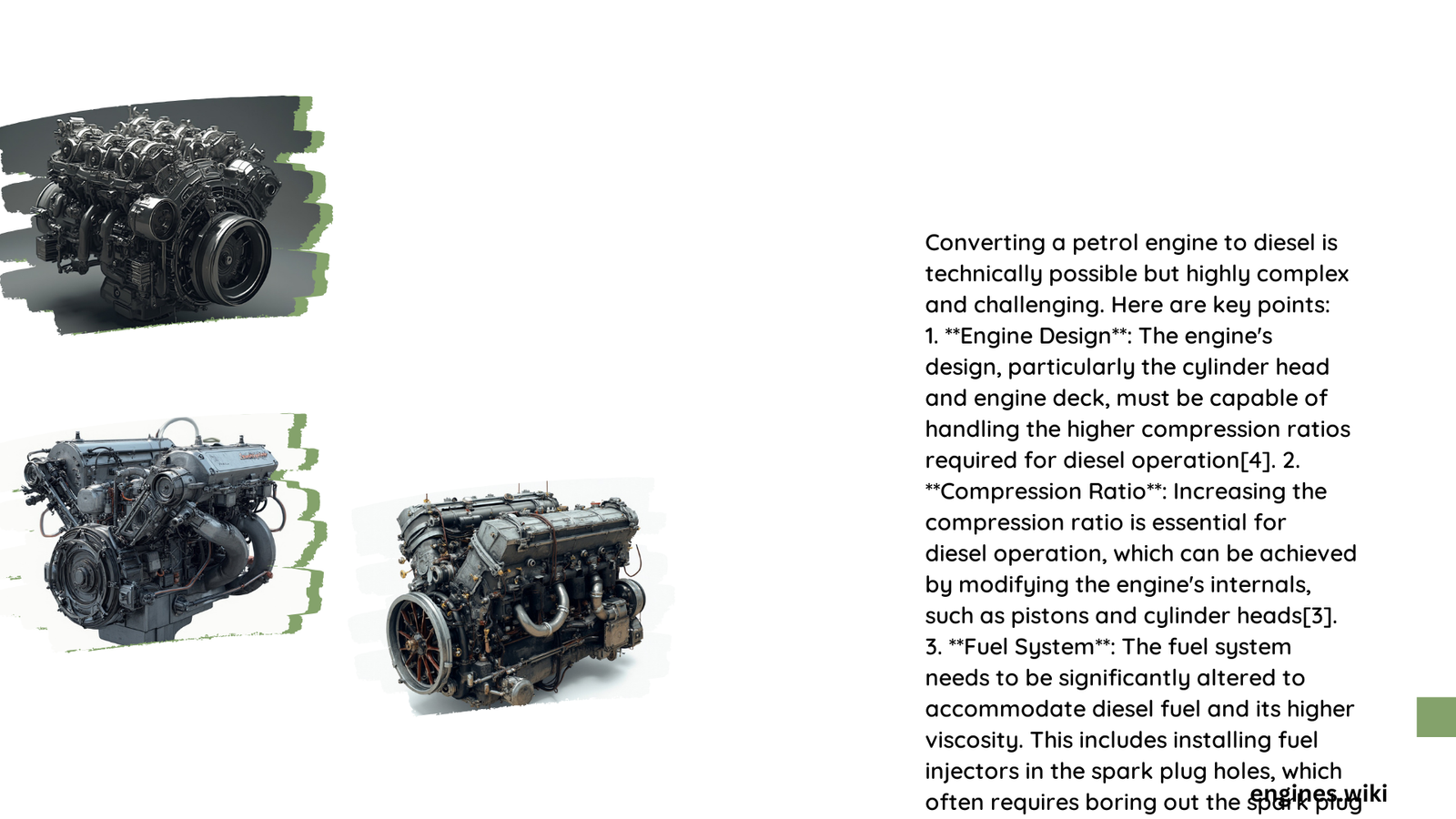Converting a petrol engine to diesel is technically possible but highly complex, expensive, and generally impractical. The process requires extensive modifications to the engine’s core components, including the compression ratio, fuel injection system, and ignition mechanism. While theoretically achievable, the cost and effort involved often outweigh the benefits, making it an uncommon practice in the automotive industry.
What Are the Main Challenges in Converting a Petrol Engine to Diesel?
The primary obstacles in converting a petrol engine to diesel include:
- Compression Ratio Adjustment
- Fuel Injection System Overhaul
- Ignition System Replacement
- Engine Block and Head Reinforcement
- Crankshaft and Camshaft Modifications
How Does the Compression Ratio Differ Between Petrol and Diesel Engines?
Petrol and diesel engines operate at significantly different compression ratios:
| Engine Type | Typical Compression Ratio |
|---|---|
| Petrol | 8:1 to 10:1 |
| Diesel | 18:1 to 22:1 |
Increasing the compression ratio to diesel levels requires substantial modifications to the engine block, cylinder head, and pistons. This alteration is one of the most challenging aspects of the conversion process.
What Changes Are Needed in the Fuel Injection System?

The fuel injection system in a diesel engine is fundamentally different from that of a petrol engine. To convert a petrol engine to diesel, you would need to:
- Remove the existing petrol fuel injection system
- Install a high-pressure diesel fuel pump
- Add new diesel fuel injectors
- Implement a completely new fuel line system
This overhaul is complex and requires precision engineering to ensure proper fuel delivery and combustion.
How Does the Ignition System Need to be Modified?
Diesel engines rely on compression ignition, while petrol engines use spark ignition. To convert a petrol engine to diesel, you must:
- Remove the entire spark plug system
- Install a diesel fuel injection system
- Potentially add glow plugs for cold starting
This change alters the fundamental way the engine initiates combustion.
What Structural Modifications Are Required for the Engine Block and Head?
Converting to diesel operation necessitates significant structural changes:
- Reinforcing the engine block to withstand higher compression pressures
- Modifying the cylinder head to accommodate diesel fuel injectors
- Potentially replacing or heavily modifying pistons and connecting rods
These modifications are crucial to ensure the engine can handle the increased stresses of diesel operation.
How Do Crankshaft and Camshaft Requirements Differ for Diesel Engines?
Diesel engines often require different crankshaft and camshaft specifications:
- Crankshaft may need reinforcement or replacement to handle higher torque
- Camshaft might require modification to adjust valve timing for diesel operation
These components play a critical role in the engine’s power delivery and efficiency.
What Is the Estimated Cost of Converting a Petrol Engine to Diesel?
The cost of conversion is prohibitively high for most applications:
| Component | Estimated Cost Range |
|---|---|
| Fuel Injection System | $5,000 – $10,000 |
| Engine Block and Head Modifications | $3,000 – $6,000 |
| New Pistons, Rods, and Crankshaft | $4,000 – $8,000 |
| Other Components (pumps, plumbing) | $2,000 – $4,000 |
| Labor Costs | $10,000 – $20,000 |
| Additional Modifications | $2,000 – $5,000 |
| Total Estimated Cost | $26,000 – $53,000 |
This high cost makes the conversion economically unfeasible for most situations.
How Long Does the Conversion Process Take?
The timeline for converting a petrol engine to diesel is extensive:
- Planning and Parts Procurement: 1-3 months
- Disassembly and Modification: 3-6 months
- Reassembly and Testing: 2-4 months
Total estimated time: 6-13 months
This lengthy process requires significant expertise and specialized equipment.
What Are the Performance Differences Between Petrol and Diesel Engines?
Diesel engines offer distinct performance characteristics compared to petrol engines:
- Higher torque at lower RPMs
- Improved fuel efficiency, especially for long-distance driving
- Different emissions profile (generally higher NOx and particulate matter, but lower CO2)
| Performance Aspect | Diesel Engine | Petrol Engine |
|---|---|---|
| Torque | 300-400 Nm at 2,000 RPM | 200-300 Nm at 4,000 RPM |
| Fuel Efficiency | 20-30 km/l | 15-25 km/l |
| CO2 Emissions | 200-300 g/km | 250-350 g/km |
These differences highlight why some prefer diesel engines for certain applications, despite the challenges of conversion.
In conclusion, while it is technically possible to convert a petrol engine to diesel, the process is extremely complex, expensive, and time-consuming. The extensive modifications required often make it impractical for most situations. Instead of conversion, it’s generally more feasible to replace the entire engine or vehicle if diesel operation is desired.
References:
1. Vehicle Conversion Basics – Alternative Fuels Data Center
2. Gas-to-Diesel conversion on single-cylinder engine? – Smokstak
3. We convert a gasoline engine to run on diesel fuel – YouTube
